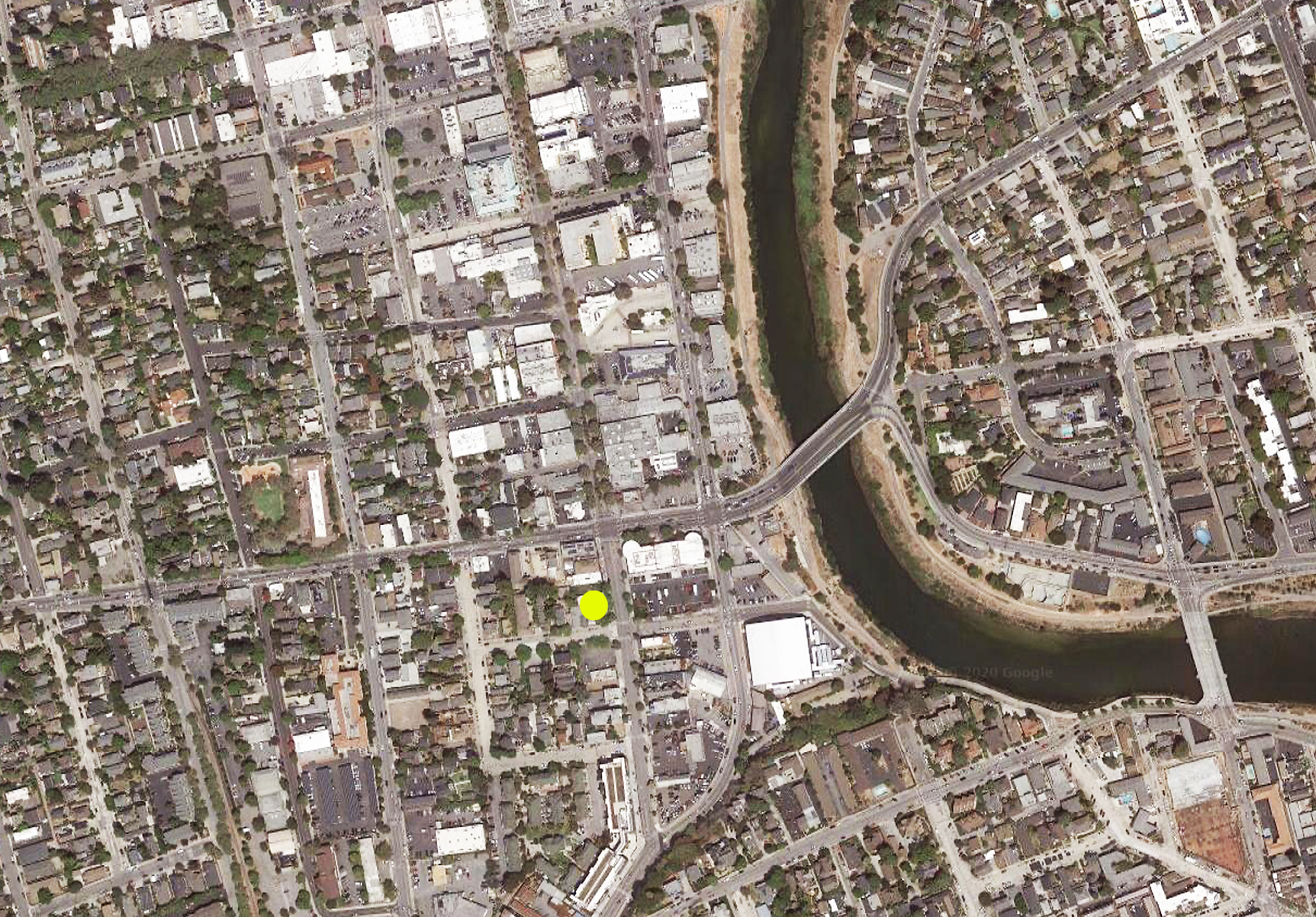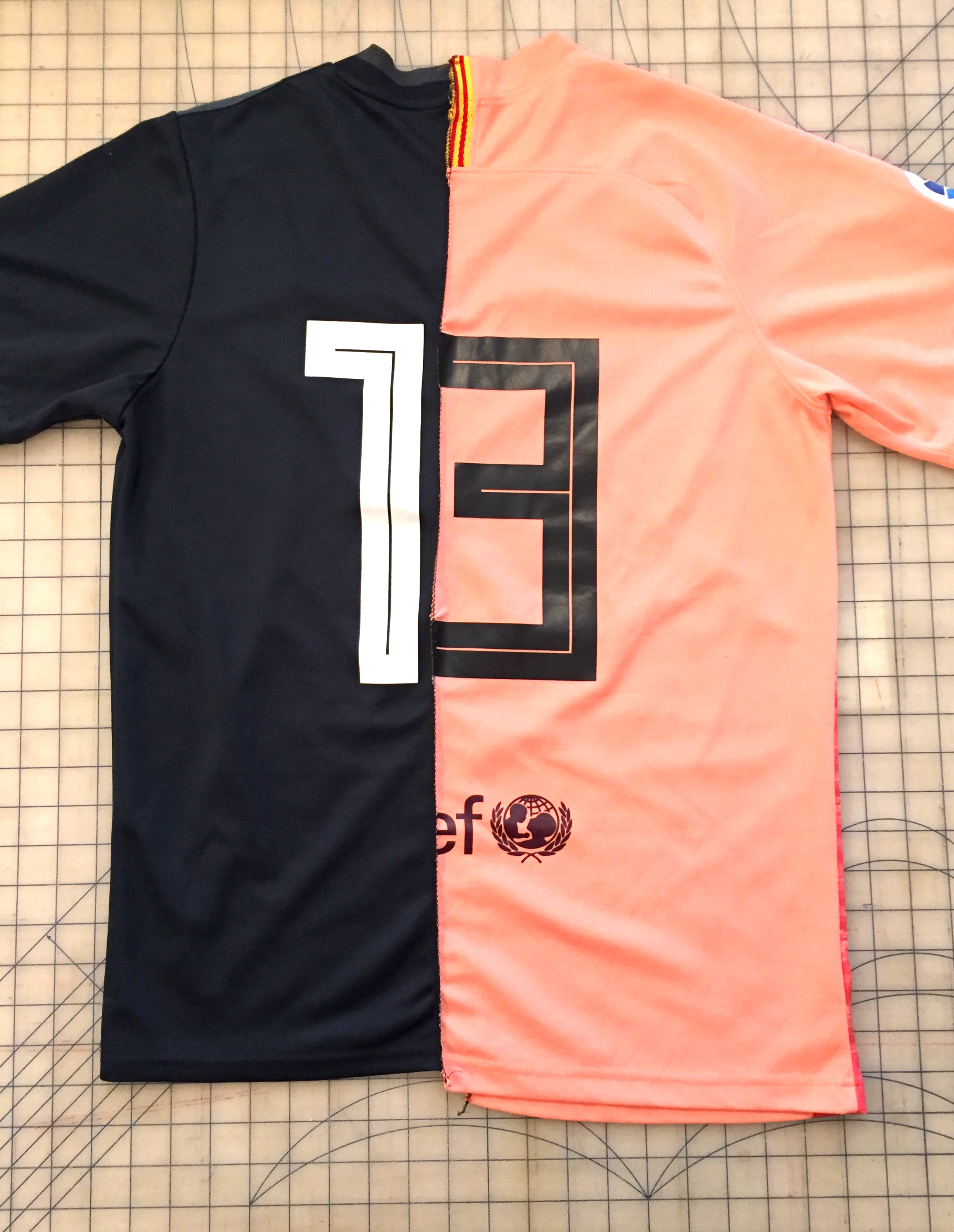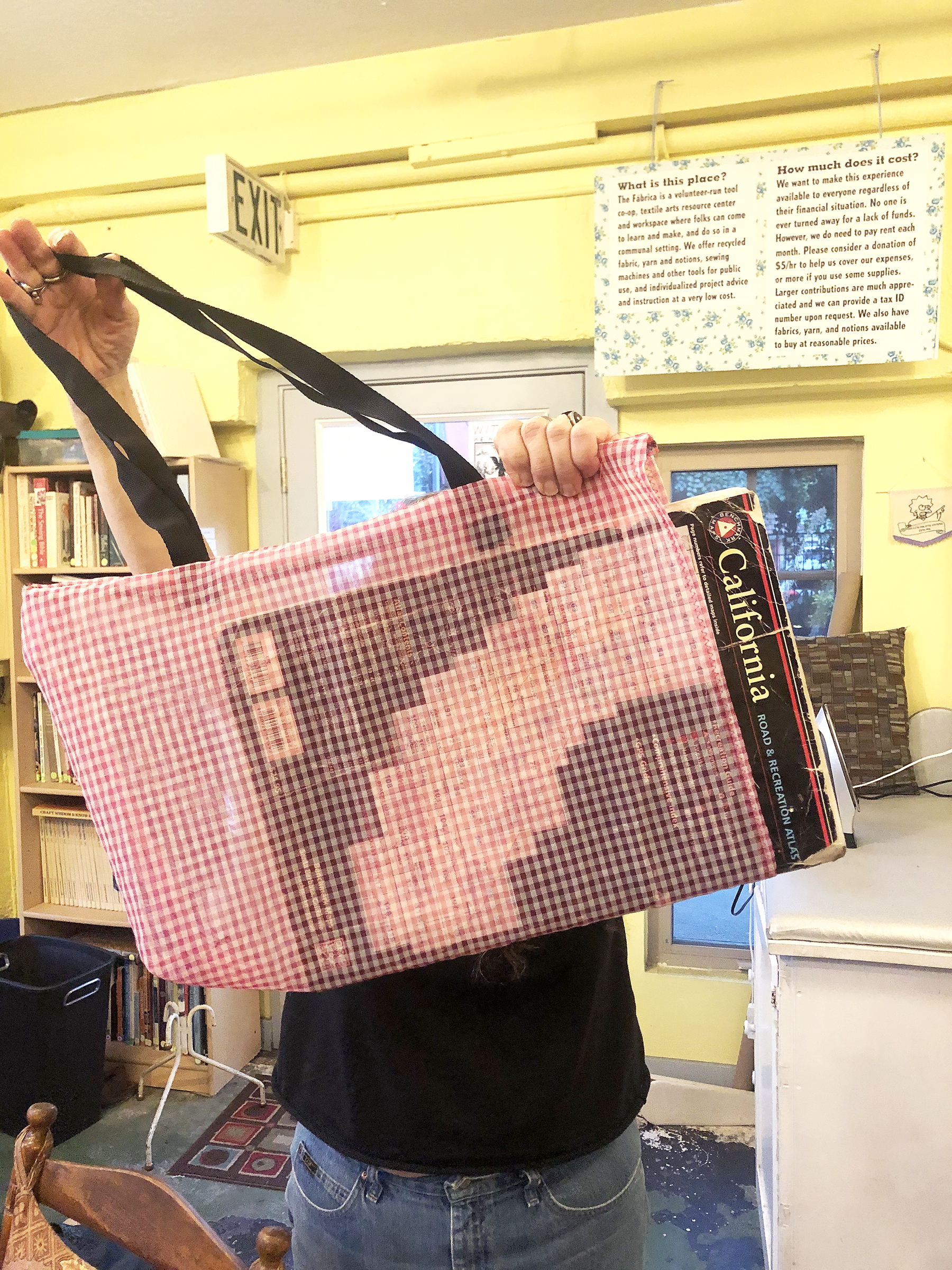
 Top: The Fábrica Community Textile and Salvage Workshop, as seen from space.
Top: The Fábrica Community Textile and Salvage Workshop, as seen from space. Bottom: Capitalism Is Killing Us" on display on at the gate to the Hub for Sustainable Living courtyard
The Fabric of Time: Exploring the Potential of Nonlinear Prefiguration
Aja Bond
Have you ever imagined a more utopic version of Santa Cruz, where the San Lorenzo river runs wild and capitalism is a notion of the past? You may be imagining Aulinta, a virtual alternate reality of Santa Cruz.
Aulinta is a speculative project that posits an alternative parallel present, where our shared timeline split in 1973 with a renewable energy revolution that started in Nigeria, and went on to create a post-scarcity, anti-capitalist, anti-colonial world.

The project creates a critical utopia, meaning there are many difficult problems that still need to be addressed, and social change is visited as a set of thorny problems, absent the bland heterogeneity that the concept of “utopia” can often bring to mind. In Aulinta, governance, language, economies, city planning and more are collaboratively thought through and implemented in a consensus-oriented way that honors Indigenous sovereignty.
In what can be called “the conventional timeline,” or, the 2020 in which COVID-19, apocalyptic wildfires, and rising fascism exist, Aulinta functions as a kind of crowd-sourced, prefigurative game in which Santa Cruz residents collaboratively think through and argue the conceptual and practical underpinnings of the project, co-creating stories and visions of a utopian reality that maps onto the current one.
Some things are completely different. The buildings of the former downtown have been relocated from the liquifacting floodplain after the 1989 earthquake. Some friends and loved ones who have died in the conventional timeline survive in Aulinta. Other things are strikingly similar; community members are likely to volunteer for roles in Aulinta that are aligned with their current interests, and many of the users’ favorite spots in town exist and are maintained in both the dystopian and utopian worlds, respectively.
![]() The Really, Really Free Market, a regular event hosted by SubRosa at the Hub
The Really, Really Free Market, a regular event hosted by SubRosa at the Hub
 The Really, Really Free Market, a regular event hosted by SubRosa at the Hub
The Really, Really Free Market, a regular event hosted by SubRosa at the Hub
The Fábrica Community Textile and Salvage Workshop
exists in both timelines.
The Fábrica opened 10 years ago as a volunteer run sewing and textile studio that is open to the public on a by-donation basis. Volunteers with a range of sewing experience support people to conceptualize, make, and repair textile-based projects. Some people who come to the space are wholly self-sufficient and just need to use one of the many sewing machines, most of which were made circa 1950 to 1970, an era of machines more durable and repairable than current models. Others come in with no experience and are shown basic skills to help them get started or to get materials from the well organized shelves and wooden library catalogue drawers that contain everything from fabric and leather, to upholstering supplies and sequins.
It's always tricky to tell a story using non-linear time, but it’s worth trying. The instigator of the Aulinta project, Blaize Wilkinson, who is known as “the keeper of the lore” in the Aulinta timeline, is a fellow member of the collective that runs the Fábrica. We talked recently about the ways that the project exists in these two different realities and we shared our thoughts about why it is so similar in both timelines.
The only real difference between the Fábrica in Aulinta and the Fábrica in Santa Cruz is the society that surrounds it, and it is that difference which affects the shape it takes.
![]()
Making a banner together at the Fábrica
The only real difference between the Fábrica in Aulinta and the Fábrica in Santa Cruz is the society that surrounds it, and it is that difference which affects the shape it takes.
Making a banner together at the Fábrica
In Aulinta, there are multiple Fábricas in different neighborhoods and they all have more space. The doors aren’t locked, because in a post-scarcity world we aren’t concerned with people stealing the stuff we need to run the project, so people can access the space day or night, regardless of whether or not they are a volunteer.
 Wassailing at the Community Orchard
Wassailing at the Community Orchard
In Aulinta, more people are knowledgeable about sewing, because making things as well as repairing them are commonly held values - it’s not a consumerist society, so that means we have more volunteers to help people to learn these skills. Other than these circumstantial differences, the project is exactly the same in Aulinta as it is in Santa Cruz, which means that the Fábrica is a utopian project.
 Hand Sewing workshop poster
Hand Sewing workshop poster
The Fábrica has everything a visitor needs to complete a textile project. There is a large filing cabinet full of vintage sewing patterns, which can be checked out. With the exception of black thread, sewing machine needles and occasionally scissors, everything in the space is recycled or has been donated. There is an old open-source PC computer which provides music and where folks occasionally look up YouTube tutorials for how to replace a zipper or do a complex seam. One wall is clear of shelves and displays textile-based artwork on a monthly basis, with openings on the first Friday of most months. There is a lending library of protest banners made by the community, inspired by artist Aram Han Sifuentes, and a library of sewing and craft-related books, magazines and zines, many of which are Fábrica originals.

Map tote-bag in progress
Almost anything you need for textile and sewing projects is here and you can use it whether or not you have money. The vast majority of people who use the space are in some way marginalized; low-income, houseless, immigrants, neurodiverse, queer and trans folks. People need to repair and alter their stuff, they need affordable/free supplies for their projects, they need knowledgeable, accessible help, or they just need company and to be around people who will offer them basic respect and dignity as they make their way through the world.
While the Fábrica has existed since 2010, it wasn’t until relatively recently that we became aware of the existence of Aulinta and the Fábrica’s divergent forms. While on a walking tour of Aulinta last year, Blaize pointed out that the Fábrica in the Aulinta timeline was housed in a large old building near my house, because, of course, the building where it exists in Santa Cruz was removed from the floodplain after 1989. The Hub for Sustainable Living (which also exists in both timelines) is the not-for-profit umbrella which offers fiscal shelter to the Fábrica as well as other radical projects in Santa Cruz including SubRosa (an Anarchist infoshop), the Bike Church (a community bike shop) and a tenant and immigrant advocacy organization called Sanctuary Santa Cruz, among others. The Hub was founded on higher ground in Aulinta because of the changing landscape and a commitment to allowing the San Lorenzo river to resume its meandering path after being contained and controlled through settler-colonial city planning.
Almost anything you need for textile and sewing projects is here and you can use it whether or not you have money. The vast majority of people who use the space are in some way marginalized; low-income, houseless, immigrants, neurodiverse, queer and trans folks. People need to repair and alter their stuff, they need affordable/free supplies for their projects, they need knowledgeable, accessible help, or they just need company and to be around people who will offer them basic respect and dignity as they make their way through the world.
While the Fábrica has existed since 2010, it wasn’t until relatively recently that we became aware of the existence of Aulinta and the Fábrica’s divergent forms. While on a walking tour of Aulinta last year, Blaize pointed out that the Fábrica in the Aulinta timeline was housed in a large old building near my house, because, of course, the building where it exists in Santa Cruz was removed from the floodplain after 1989. The Hub for Sustainable Living (which also exists in both timelines) is the not-for-profit umbrella which offers fiscal shelter to the Fábrica as well as other radical projects in Santa Cruz including SubRosa (an Anarchist infoshop), the Bike Church (a community bike shop) and a tenant and immigrant advocacy organization called Sanctuary Santa Cruz, among others. The Hub was founded on higher ground in Aulinta because of the changing landscape and a commitment to allowing the San Lorenzo river to resume its meandering path after being contained and controlled through settler-colonial city planning.
 Granny Peace Brigade banner, in progress, reverse-side view
Granny Peace Brigade banner, in progress, reverse-side viewOn the tour, with Blaize pointing to invisible but imaginable cable cars and donkey corrals, my grasp of linear time relaxed and I started to see these other possibilities overlaying my current reality, existing just beyond the surface. “My tours aren’t about completeness; they’re about bits and pieces,” says Blaize, “...the final strangeness is that I’m giving a tour of things that don’t exist.” So as we walked past the building full of offices and an Italian restaurant, I could sense that in the other timeline, I have walked here hundreds of times to come to my volunteer shift, instead of downtown–which is now a seasonal wetlands. In the disorientation of this experience, I wonder if I am not only seeing into one possible alternative reality, but also another in the future, or perhaps more accurately, one of many possible futures.
![]()
Top: Greta on the floor of the Fábrica with embroidery hoops
Bottom: Making a Mend banner at the Museum of Art and History
This kind of nonlinear prefiguration adds layers of complexity to utopian thinking and practice. We can’t just dream about multi-dimensional reality all day, we still need to work through the basic logistics:
how do we pay rent during COVID-19, when we have felt it necessary to close the space out of concern for public safety; and how do we make our resources available as we withstand this marathon pandemic in the midst of fires and the violent policing of people of color and houseless and poor folks in this town. But as the social fabric continues to unravel and we increasingly find ourselves in a kind of isolation-induced fever-dream, the possibilities of imagination may become more expansive. Set against the dystopian tableau of the present, we find other realities making themselves available to us. Both Aulinta and the Fábrica are shelters of revolutionary love: one grounded in practical, material and very real social needs, and the other in the need for a place to maintain and proliferate our ever-changing shared dreams as we struggle to make them real.

 Top: Sophie Lev in a naturally dyed shirt
Top: Sophie Lev in a naturally dyed shirtBottom: The Night Market, a monthly event for local vendors
More about the Fábrica: website, IG @the_fabrica_
More about Aulinta; website, wiki
See also: Aram Han Sifuentes Protest Banner Lending Library